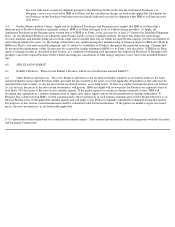Apple 2003 Annual Report Download - page 94
Download and view the complete annual report
Please find page 94 of the 2003 Apple annual report below. You can navigate through the pages in the report by either clicking on the pages listed below, or by using the keyword search tool below to find specific information within the annual report.
1.6 “Exhibit 4 Products” means those specific Products set forth on the attached Exhibit 4, including those in its footnotes.
1.7 “Failed Units” means specific units of a particular Exhibit 4 Product, or any other ASIC Product that the parties may agree to treat in
a similar manner, sold hereunder that exhibited a Failure or can be predicted with a reasonable certainty to exhibit a Failure prior to the
expiration of the [**] commencing on the date such units were manufactured.
1.8 “Failure” means that the unit of Exhibit 4 Product or the unit of any other ASIC Product that the parties may agree to treat in a
similar manner does not operate in conformance with the agreed upon (in writing) specifications (in ASIC Products, such specifications will be
set forth in the RTM as that term is defined in the ASIC Development Agreement, Agreement No. 000798) and [**] and which reasonably
could not have been detected by Apple through system, subsystem, and part testing activities which are no less thorough than (i) for both the
ASIC and PowerPC Exhibit 4 Products, those testing activities generally conducted by Apple but not less thorough than those testing activities
generally conducted by other personal computer manufacturers (but not microprocessor manufacturers) in the industry, or (ii) for PowerPC
Exhibit 4 Products, after a test specification is agreed upon by IBM and Apple pursuant to Section 14.1 of this Agreement, those testing
activities to be conducted by Apple as described in such test specification.
1.9 “Failure Threshold.” For each Exhibit 4 Product, or any other ASIC Product that the parties may agree to treat in a similar manner,
sold under this Agreement, the Failure Threshold shall be [**] of the total number of units of the particular Product manufactured [**] and
shipped by IBM.
1.10 “Forecast” means a non-binding monthly forecast in substantially the same format shown in Exhibit 3 specifying the number of
Products Apple anticipates that its Authorized Purchasers and Designees will purchase from IBM each month during the specified period.
1.11 “Item” means any part, specification, design, document, report, data or the like which Apple delivers to IBM under this Agreement.
1.12 “Plant” means the IBM-Related Company described in Section 2.6.
1.13 “PowerPC Product” means a stand-alone microprocessor Product based on the PowerPC Architecture.
[**] = information redacted pursuant to a confidential treatment request. Such omitted information has been filed separately with the Securities
and Exchange Commission.
























